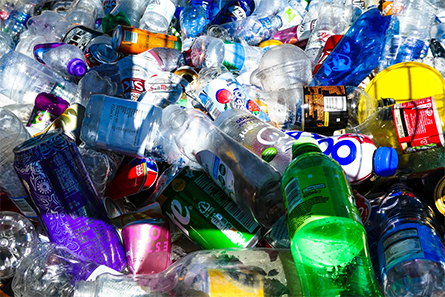Linking two enzymes turns plastic-eating bacteria into super-digesters
Plastic is everywhere. Scientists have found tiny bits of microplastic even in the extremes of the Earth – from the deep-sea of the Mariana Trench to the peaks of the Pyrenees – and damaging life around us. While source reduction can be one of the most effective ways to reduce plastic waste, how do we deal with all of the plastic that already exists, polluting our oceans and overflowing out of landfills?

Polyethylene terephthalate, also known as PET and one of the most common types of plastic, is unfortunately notoriously difficult to break down. In 2016 however, scientists found a new species of bacteria outside of a bottle-recycling facility capable of decomposing plastic. The discovery revealed that the bacteria's abilities depend on two specific enzymes. These enzymes work together in a two-step process to break plastic down into smaller molecules that the bacteria can turn into energy.
A new study published in the Proceedings of the National Academy of Sciences demonstrates a way to improve the two-enzyme system. While naturally existing as two separate enzymes – PETase and MHETase – the researchers physically linked them together. The attached enzymes worked together more efficiently than the same two enzymes when unlinked. Depending on the length of the linking segment between them, the attached enzymes were able to release almost double the amount or more of the final broken down product.
With this process, PET, could be broken down by the bacteria in days, a process which would take hundreds of years in the environment.
But breaking down plastic only deals with part of the issue of plastic waste. Recovering the plastic waste already in the ocean and other corners of the planet to deliver to recycling or decomposing facilities remains a daunting challenge. And even faced with the knowledge that we need to reduce plastic, the world has only been ramping up its production levels. Although these results are exciting, we're still far from solving our growing plastic problem.
This story originally appeared on Massive Science, an editorial partner site that publishes science stories by scientists. Subscribe to their newsletter to get even more science sent straight to you.
Enjoy reading ASBMB Today?
Become a member to receive the print edition four times a year and the digital edition monthly.
Learn moreGet the latest from ASBMB Today
Enter your email address, and we’ll send you a weekly email with recent articles, interviews and more.
Latest in Science
Science highlights or most popular articles

Bacteriophage protein could make queso fresco safer
Researchers characterized the structure and function of PlyP100, a bacteriophage protein that shows promise as a food-safe antimicrobial for preventing Listeria monocytogenes growth in fresh cheeses.

Building the blueprint to block HIV
Wesley Sundquist will present his work on the HIV capsid and revolutionary drug, Lenacapavir, at the ASBMB Annual Meeting, March 7–10, in Maryland.

Gut microbes hijack cancer pathway in high-fat diets
Researchers at the Feinstein Institutes for Medical Research found that a high-fat diet increases ammonia-producing bacteria in the gut microbiome of mice, which in turn disrupts TGF-β signaling and promotes colorectal cancer.

Mapping fentanyl’s cellular footprint
Using a new imaging method, researchers at State University of New York at Buffalo traced fentanyl’s effects inside brain immune cells, revealing how the drug alters lipid droplets, pointing to new paths for addiction diagnostics.

Designing life’s building blocks with AI
Tanja Kortemme, a professor at the University of California, San Francisco, will discuss her research using computational biology to engineer proteins at the 2026 ASBMB Annual Meeting.

Cholesterol as a novel biomarker for Fragile X syndrome
Researchers in Quebec identified lower levels of a brain cholesterol metabolite, 24-hydroxycholesterol, in patients with fragile X syndrome, a finding that could provide a simple blood-based biomarker for understanding and managing the condition.

